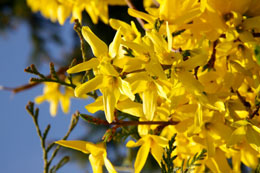Plant a forsythia bush and appreciate its strikingly beautiful yellow blooms in early spring. This article lists some growth and care tips for you to grow healthy bushes.

The forsythia bush―scientific name
Forsythia intermedia―is a landscaping shrub well-adapted to temperate climatic conditions. Sharing plant family with olives, the genus forsythia comprises 11 species indigenous to Asia and Europe. This bush is deciduous and grows to a height of about 3-9 feet from the ground. Leaves are simple or trifoliate (3 leaflets) borne in opposite phyllotaxy. Bright yellow flowers bloom in the spring. Hence, this bush is widely grown in parks and yards.
Growth and Care
The two widely grown cultivars are
F. intermedia and
F. suspensa, with the former variety being more popular. They are extremely hardy, thus require less effort to maintain healthy plants.
Variety
Based on your garden plans, select a suitable bush cultivar. While some varieties grow to a mere 1-2 feet in height, others can grow to more than 8 feet. Most of the species are hardy within USDA zones 4-9. Hence, hardiness is not a prime concern while choosing a forsythia cultivar. Take into account the plant's height, flower color, and flower size when selecting a bush.
Propagation
The best method for propagating a forsythia plant is by cutting the stem. Commercial propagation is done as soon as the flowering period is over in the late spring and continues until early summer. Another interesting way is by placing a weight over the branches and forcing them to touch the ground soil. With time, the lower boughs will develop roots, after which cutting and transplanting the bush is done.
Planting
The forsythia plant thrives well in full sun, though it can tolerate partially shaded conditions. The soil should be rich and well-drained for healthy growth. Accordingly, you can supplement garden soil with peat moss and farmyard compost in order to restore plant nutrients. You can use the forsythia for mass plantation, shrub borders, and screening purposes. Either way, the bush will liven up your yard with blossoms.
Care
Even though the forsythia is adaptable to highly polluted and less hospitable areas, providing optimal growth conditions is best for timely flowering. The watering schedule is not specific. You can irrigate the bush whenever the top soil dries out. Applying an all-purpose liquid fertilizer in mid-February will bring about heavy blooms. Though the bush is resistant to most pests, weevils, bugs, fungus, and aphids may infest the plants when they are exposed to prolonged stress conditions.
Pruning
It is to be borne in mind that flowers bloom in the last stage of growth, prior to development of leaves. Hence, the best time for pruning is when the blooms start fading in color. Mark the lower branches (about 4 inches from the ground) and diseased twigs to be pruned down. Removing one-fourth of old branches is sufficient to promote healthy growth of the bush.
Similar to other shrubs and bushes, pruning is a basic gardening routine for maintenance of healthy forsythia bushes. Being one of the earliest spring-flowering plants, your forsythia plant will bear spectacular blossoms as soon as spring arrives. Hobbyists often practice the technique of inducing flowers by the end of winter.






 The forsythia bush―scientific name Forsythia intermedia―is a landscaping shrub well-adapted to temperate climatic conditions. Sharing plant family with olives, the genus forsythia comprises 11 species indigenous to Asia and Europe. This bush is deciduous and grows to a height of about 3-9 feet from the ground. Leaves are simple or trifoliate (3 leaflets) borne in opposite phyllotaxy. Bright yellow flowers bloom in the spring. Hence, this bush is widely grown in parks and yards.
The forsythia bush―scientific name Forsythia intermedia―is a landscaping shrub well-adapted to temperate climatic conditions. Sharing plant family with olives, the genus forsythia comprises 11 species indigenous to Asia and Europe. This bush is deciduous and grows to a height of about 3-9 feet from the ground. Leaves are simple or trifoliate (3 leaflets) borne in opposite phyllotaxy. Bright yellow flowers bloom in the spring. Hence, this bush is widely grown in parks and yards.